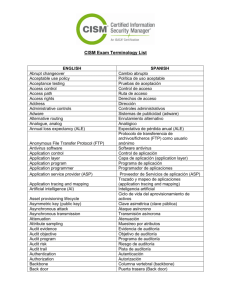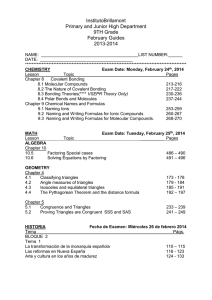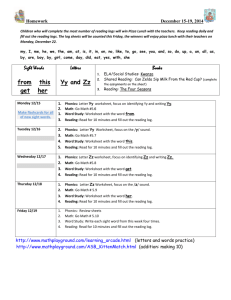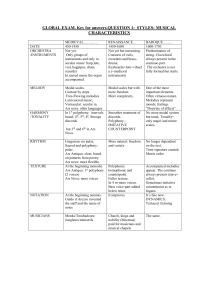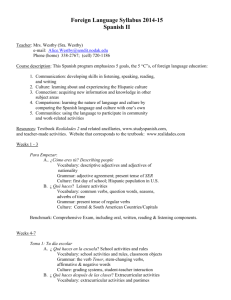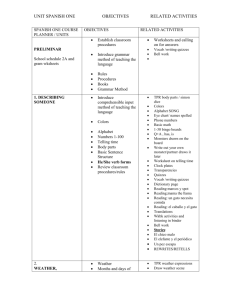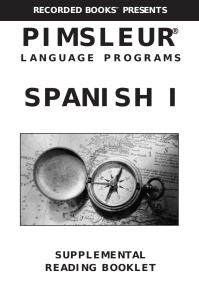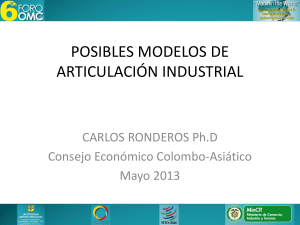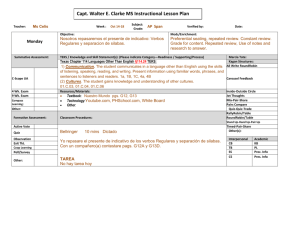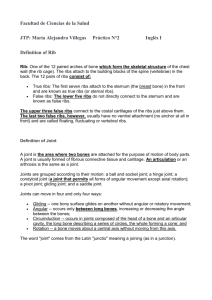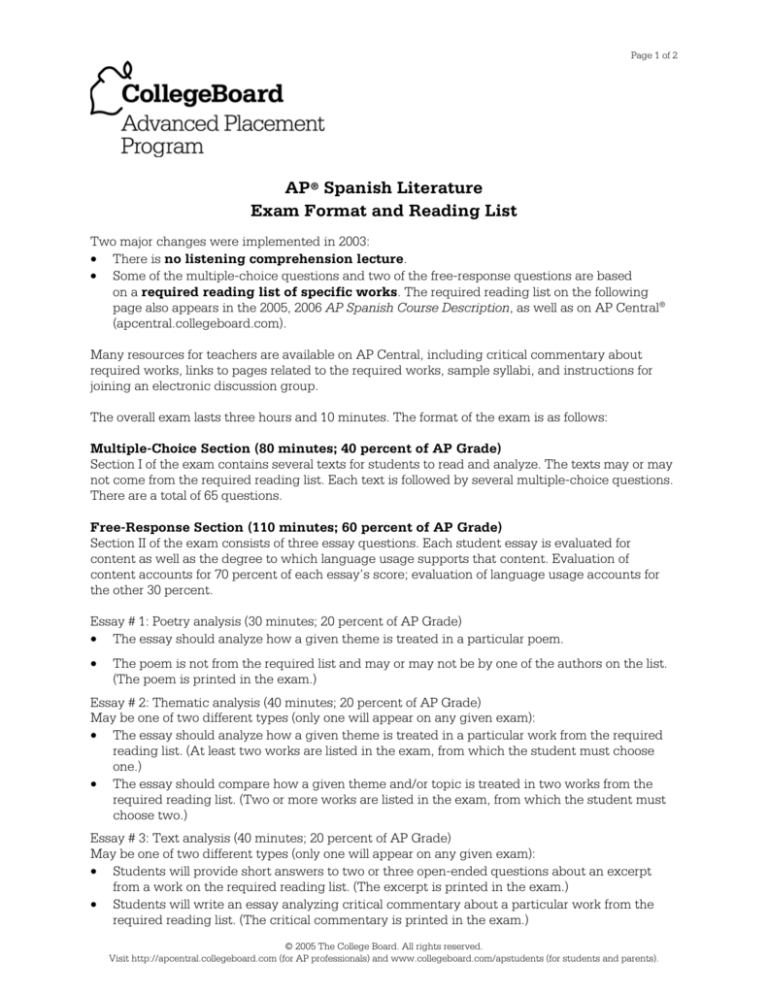
Page 1 of 2
AP® Spanish Literature
Exam Format and Reading List
Two major changes were implemented in 2003:
• There is no listening comprehension lecture.
• Some of the multiple-choice questions and two of the free-response questions are based
on a required reading list of specific works. The required reading list on the following
page also appears in the 2005, 2006 AP Spanish Course Description, as well as on AP Central®
(apcentral.collegeboard.com).
Many resources for teachers are available on AP Central, including critical commentary about
required works, links to pages related to the required works, sample syllabi, and instructions for
joining an electronic discussion group.
The overall exam lasts three hours and 10 minutes. The format of the exam is as follows:
Multiple-Choice Section (80 minutes; 40 percent of AP Grade)
Section I of the exam contains several texts for students to read and analyze. The texts may or may
not come from the required reading list. Each text is followed by several multiple-choice questions.
There are a total of 65 questions.
Free-Response Section (110 minutes; 60 percent of AP Grade)
Section II of the exam consists of three essay questions. Each student essay is evaluated for
content as well as the degree to which language usage supports that content. Evaluation of
content accounts for 70 percent of each essay’s score; evaluation of language usage accounts for
the other 30 percent.
Essay # 1: Poetry analysis (30 minutes; 20 percent of AP Grade)
• The essay should analyze how a given theme is treated in a particular poem.
•
The poem is not from the required list and may or may not be by one of the authors on the list.
(The poem is printed in the exam.)
Essay # 2: Thematic analysis (40 minutes; 20 percent of AP Grade)
May be one of two different types (only one will appear on any given exam):
• The essay should analyze how a given theme is treated in a particular work from the required
reading list. (At least two works are listed in the exam, from which the student must choose
one.)
• The essay should compare how a given theme and/or topic is treated in two works from the
required reading list. (Two or more works are listed in the exam, from which the student must
choose two.)
Essay # 3: Text analysis (40 minutes; 20 percent of AP Grade)
May be one of two different types (only one will appear on any given exam):
• Students will provide short answers to two or three open-ended questions about an excerpt
from a work on the required reading list. (The excerpt is printed in the exam.)
• Students will write an essay analyzing critical commentary about a particular work from the
required reading list. (The critical commentary is printed in the exam.)
© 2005 The College Board. All rights reserved.
Visit http://apcentral.collegeboard.com (for AP professionals) and www.collegeboard.com/apstudents (for students and parents).
Page 2 of 2
AP Spanish Literature Required Reading List
Students should read authentic editions (abridged or translated versions are not appropriate) of all the works on this
list, except where choice is indicated. Works from the list will be specifically asked about on the AP Spanish
Literature Exam.
This list is organized by period and author, but of course the works need not be presented in this particular order. The
list lends itself to curricula structured to highlight theme, genre, and other qualities of the works.
Medieval & Golden Age
19th Century
• Anónimo
“Romance de la pérdida de Alhama” (“Ay de mi Alhama”)
• Alas, Leopoldo (Clarín)
“Adiós, Cordera”
• Anónimo
“Romance del Conde Arnaldos” (Versión de 26 versos)
• Bécquer, Gustavo Adolfo
Rimas, IV (“No digáis que agotado su tesoro”)
Rimas, XI (“Yo soy ardiente, yo soy morena”)
Rimas, LIII (“Volverán las oscuras golondrinas”)
• Anónimo
Lazarillo de Tormes: Tratados 1, 2, 3, 7
• Cervantes Saavedra, Miguel de
El ingenioso hidalgo, don Quijote de la Mancha: Primera parte,
capítulos I, II, III, IV, V y VIII
• Darío, Rubén (Félix Rubén García Sarmiento)
Cantos de vida y esperanza: Otros poemas, VI (“Canción de
otoño en primavera”)
Cantos de vida y esperanza: Otros poemas, XLI (“Lo fatal”)
Cantos de vida y esperanza, VIII (“A Roosevelt”)
• Cruz, Sor Juana Inés de la
“En perseguirme, Mundo, ¿qué interesas?” (Quéjase de la
suerte: insinúa su aversión a los vicios, y justifica su
divertimiento a las Musas)
“Hombres necios que acusáis” (Sátira filosófica: Arguye de
inconsecuentes el gusto y la censura de los hombres que en
las mujeres acusan lo que causan)
• Espronceda, José de
“Canción del pirata”
• Góngora y Argote, Luis de
Soneto CLXVI (“Mientras por competir con tu cabello”)
• Larra, Mariano José de
“Vuelva Ud. mañana”
• Juan Manuel, Infante de Castilla
Conde Lucanor: Exemplo XXXV.º (“Lo que sucedió a un mozo
que casó con una mujer muy fuerte y muy brava”)
• Martí, José
“Dos patrias” (“Dos patrias tengo yo: Cuba y la noche”)
Versos sencillos, I (“Yo soy un hombre sincero”)
• Núñez Cabeza de Vaca, Álvar
Naufragios: Capítulos XII (“Cómo los indios nos trajeron de
comer”), XX (“De cómo nos huimos”), XXI (“De cómo
curamos aquí unos dolientes”) y XXII (“Cómo otro día nos
trajeron otros enfermos”)
• Palma, Ricardo
“El alacrán de Fray Gómez”
• Heredia, José María
“En una tempestad”
• Pardo Bazán, Emilia
“Las medias rojas”
• Quevedo y Villegas, Francisco de
Heráclito cristiano: Salmo XVII (“Miré los muros de la patria
mía”)
• Téllez, Gabriel (Tirso de Molina)
El burlador de Sevilla y convidado de piedra
• Vega, Garcilaso de la
Soneto XXIII (“En tanto que de rosa y de azucena”)
20th Century
• Allende, Isabel
“Dos palabras”
• Borges, Jorge Luis
“El sur”
“La muerte y la brújula”
• Burgos, Julia de
“A Julia de Burgos”
• Castellanos, Rosario
“Autorretrato”
• Cortázar, Julio
“Continuidad de los parques”
“La noche boca arriba”
• Fuentes, Carlos
“Chac Mool”
• García Lorca, Federico
La casa de Bernarda Alba
Dos romances del Romancero gitano
• García Márquez, Gabriel
Tres cuentos, elegidos de la lista
siguiente
“Un día de éstos”
“El ahogado más hermoso del
mundo”
“La prodigiosa tarde de Baltazar”
“Un señor muy viejo con unas
alas enormes”
“La viuda de Montiel”
“La siesta del martes”
• Guillén, Nicolás
“Balada de los dos abuelos”
“Sensemayá”
• Machado, Antonio
“He andado muchos caminos”
“La primavera besaba”
“Caminante, son tus huellas”
• Martín Gaite, Carmen
“Las ataduras”
• Neruda, Pablo (Ricardo Neftalí Reyes
Basoalto)
“Oda a la alcachofa”
Residencia en la Tierra 2, “Walking
around”
Veinte poemas de amor y una canción
desesperada, Poema 15 (“Me
gustas cuando callas porque estás
como ausente”)
• Quiroga, Horacio
“El hijo”
• Rulfo, Juan
“No oyes ladrar los perros”
• Storni, Alfonsina
“Peso ancestral”
“Tú me quieres blanca”
• Ulibarrí, Sabine R.
“Mi caballo mago”
• Unamuno y Jugo, Miguel de
San Manuel Bueno, mártir
• Vodanovic, Sergio
El delantal blanco
© 2005 The College Board. All rights reserved.
Visit http://apcentral.collegeboard.com (for AP professionals) and www.collegeboard.com/apstudents (for students and parents).

